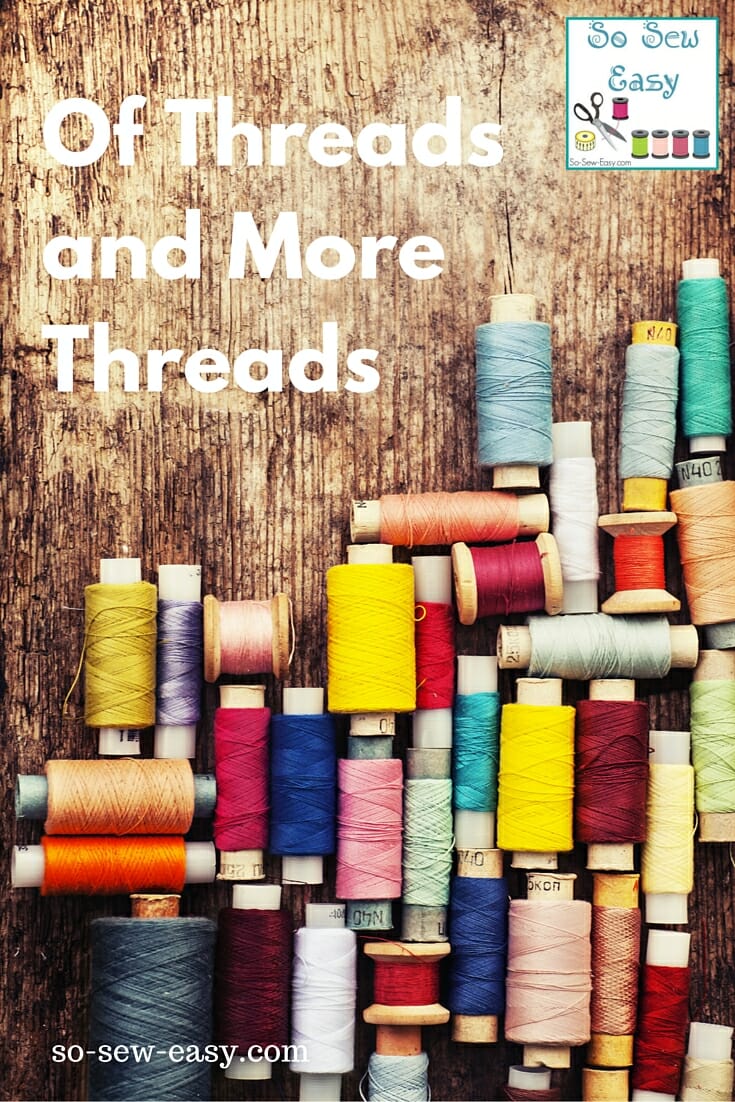
A good sewist should know her or his sewing thread. Whether sewing by hand or by machine, this means you should be able to determine the right quality of thread for each of your sewing projects. A good quality sewing thread generally translates to a better sewing experience because it will not break or tangle easily. This is especially true if you sew frequently, and until the wee hours of the morning like I do.
Fortunately, quality thread need not always be the most expensive brand in the market. There are relatively inexpensive threads that are as good as the pricey ones. The trick is to know how to determine thread quality. So here’s how to do it: Inspect a strand of thread by holding it up to a bright light and then inspect how much lint or fray is deviating from it. A high quality thread should only have a few fibers deviating from the main strand and should be tightly bound together. A thread is not like a piece of steel wire, so it will always have some loose fibers but the less there are, usually the higher the quality of your thread.
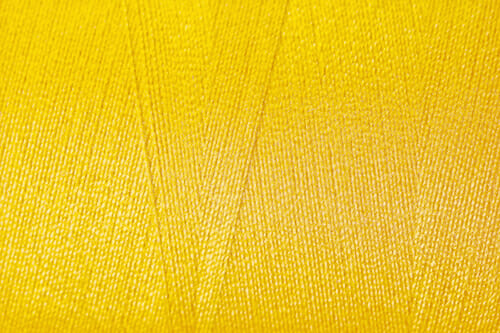

Sewing threads, as we all know, are made from synthetic or natural fibers, or both, and each has its own useful attributes.
Rayon Sewing Thread – the popular choice, particularly for embroidery
Rayon thread is made from synthetic fibers and is one of the most popular choices among experienced sewers because it is attractive, easily available, and consistent. This type of thread has a good sheen and comes in a big range of colors. However, a disadvantage of rayon is that it is not always colorfast and it can deteriorate over time so requires proper maintenance. The best quality rayon almost always comes from the US or Europe. As strange as it sounds, I've read that the best way to store and prolong the life of your rayon thread is to keep it in the freezer! Just be sure to warm it up before you start to sew..
Polyester Sewing Thread – the all-around workhorse
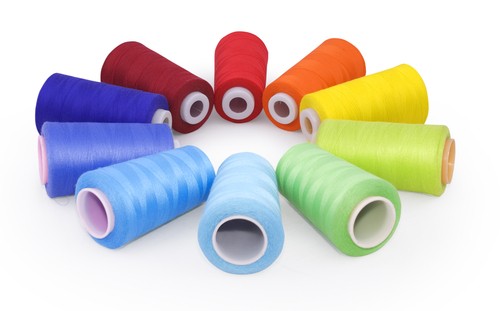

Polyester sewing thread is often the best all-around and all-purpose thread. And for those who want to save money, polyester sewing thread is the popular choice. Because polyester has some give, it will stretch a little making it a good choice for sewing stretchy fabrics like knits. Occasionally manufacturers add some sort of silicone or wax finish to allow the thread to more easily pass through the fabric. Polyester thread is often wrapped in cotton for general-purpose use and is also available in a wide array of colors.
Ideal for children’s clothes, polyester does not easily shrink or fade when washed. It has a slightly lesser sheen when compared to rayon thread but the quality is almost the same so that when you use both of them in a single item or design, it will be difficult to see the difference.
Cotton Sewing Thread – beautiful but sometimes not so strong
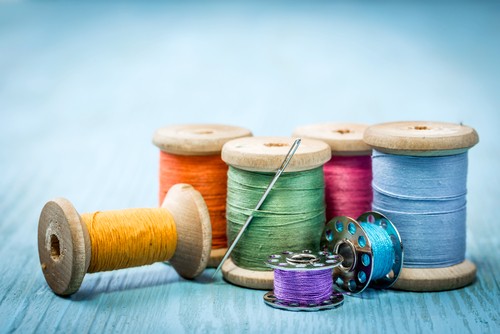

Often overlooked, cotton thread performs beautifully when used in certain projects. However, because cotton sewing thread has very little stretch or give, it can break more easily than polyester or rayon. It can often be a good choice for sewing lingerie or other delicate fabrics. Sometimes considered as having an heirloom quality to it, this thread provides a soft and lovely sheen to your finished product. Just stay away from finer cotton threads because they tend to be weaker. Best to stick with medium-thickness cotton thread and use it on mid-weight cotton, linen, or rayon fabric.
Silk Thread – my favorite!
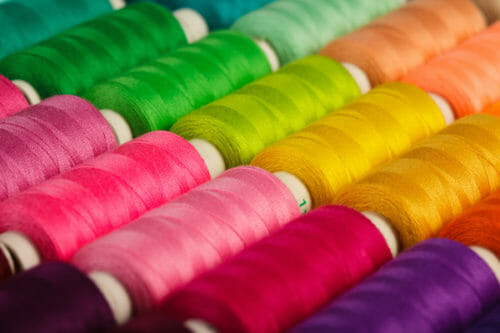

My personal favorite is the silk thread because it absorbs colors brilliantly to give your sewing that rich and brilliant sheen incomparable to other thread types. Strong without being abrasive, it is smooth to use and does not break easily. Silk thread is very fine and flexible. It won't leave holes in the fabric so it makes a great choice for a basting thread. Since silk thread is expensive, it is often only used for luxurious fabrics and in tailoring. The good news is that silk thread is becoming widely available and it comes in a brilliant range of sizes. This is a thread that is truly fit for royalty!
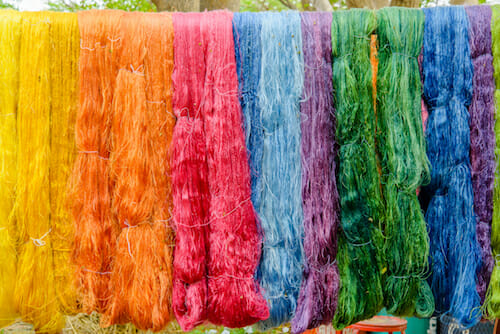

Other Sewing Threads
There are of course many, many other kinds of threads out there including wool, nylon, and metallic but we don't have the space to go into them all here, unfortunately. What's the most exotic kind of thread you've ever used? Let us know in the comments below.
Where to Find the Best Thread
We're often asked where's the best place to find a wide selection of good quality sewing thread. You can certainly buy lots of different kinds and qualities of threads at normal retailers like Walmart. A quick search for sewing thread on Amazon shows almost 100,000 items!
However, we've found for the best quality and selection, particularly for hard-to-find embroidery threads or high-quality silk thread, it is often best to stick to a specialist thread supplier and one of the best is certainly ThreadArt. You can check out their wide selection of polyester, rayon, and cotton thread HERE. They even have invisible thread. For silk thread, try Joann.com HERE.
We also carry a good selection of high-quality serger threads right here on the So Sew Easy store.








My biggest peeve with thread is trying to determine the weight. Spools used to always be marked but now nothing. Some sewing projects require a lighter or heavier weight and I am left guessing. Am I missing something?
No, it is how the industry has evolved.
Thanks for this article! I am definitely going to look up those sources provided. I used to get polyester thread from Jo Ann for pretty much all my projects. They usually sell Coates & Clark, Guttermann, and Sulky. I never tried Sulky but now that I am in Europe, my guess is that I will try to find the rayon thread and give it a shot. I did know that “scruffy” thread as I like to call it could only be kept AWAY from my machine and any project 😲 …The lint is destructive to any sewing machine! I so far have used “lint plagued” thread for hand basting never for actual projects. Also, an occasional loose button gets those not so good threads. I very much appreciate this article. 😉 😀
I am delighted you found it helpful.
I have a large range of thread, some inherited, some bought for general sewing, some for quilting, some big spools discounted from a work wear manufacturer, some fancy ones and some budget ones too. I try and keep them semi organised by type so it’s easy to grab the right thread for the job. My misson is to try and use up what I have before buying any more. That means making sure to use the cheap thread whenever I get the chance, tacking, basting etc and sometimes getting creative with colour choices!
Indeed this is a good plan.
Who has dissolving thread,?
Could someone advice on what is the best way to store thread?
I didn’t find silk thread when I went to Thread Art website. Did I miss it?
Hi Audrey, thanks for letting me know that. Not sure what happened. They always used to have a good selection of silk thread. I’ve updated the article with another source at Joann.com. You can check it out here: https://so-sew-easy.com/l/silk_thread
I’m on a tight budget and have found Guterman (spelling) is the best for me. I use their polyester threads for a lot of my hand-quilting. For machine piecing I use 100% cotton from Essentials. It doesn’t break and is really nice quality. I know it’s kind of linty, but if you don’t mind cleaning your sewing machine between projects it’s a wonderful small-budget thread and the spools are often large. I’ve also used them for hand-quilting, but they tend to tangle even with a thread conditioner. My favorite type of thread is variegated cotton, but it’s so expensive! I splurged and bought my first spool of Sulky variegated thread for hand-quilting. I haven’t used it yet, but it was the rainbow colors I’d been looking for. The variegated thread within my budget is Dual Duty XP; not the best but’s never torn or tangled. I recently received two spools of Sewing Basket polyester thread. The worst thread I’ve used is Coats; it’s not terrible but definitely towards the bottom of my list.
As posted by Grammy above, rayon is NOT synthetic for the reasons she gives. However it does rely heavily on chemical processing so if you are looking for natural fibres it may not be your best choice.
Hmmm, confused. Rayon thread is not a synthetic, it is basically regenerated cellulose. In other words, wood. It is then mixed with chemicals and processed. My favorite test for thread origins is to burn some and observe the results. Natural fibers burn to ash, synthetic ones melt.
I have used variegated metallic threads quite a bit as I love the way they look on fabric, but not always easy to use! Thanks for this great lesson today!
It’s not exotic, but I love sewing with invisible thread! It hides a multitude of small sins. 😉
The most exotic I have ever used is some very fine yarn that my sister gave me. She makes it with her spinning wheel and then works it into how many plies, etc, from bags of wool. It’s beautiful with a wonderful soft sheen. I am so lucky. Silk does not fit into my budget, but I did splurge on 2 collections of Sulky polyester threads that I bought from HSN. I also found some serger thread that had great reviews at Amazon. Low price and great quality. Sorry. I know, TMI (too much information). I love all of the information you share and find it quite valuable. Thank you so much for being there. Cheryl
I loved reading your post. I hope to seek out some of that home spun wool from one of my weaving friends!!! Thanks for this idea! Never too much information!!!
My sawing machine say to use 40 thread how do I find the right size because at walmart doesn’t have any numbers on them
I am assuming that you are using a digitized design on an embroidery machine. Walmart is not the place to buy such threads, try fabric.com
I have been sewing for a long time but good information. I will print it out and post to my sewing wall. I have a lot of Rayon and Polyester threads I inherited.
Mom had a fabric and notions store in the early 60’s ….I grew up in that store learning to count the threads, zippers, buttons and fabric. Mom passed away 8 years ago and still had loads of fabric, zippers, buttons and thread still left from her store. The fabric were all wrapped with tissue paper in between, the zippers still in the original wrappers, the thread (Clarks) were kept in the original box along with original embroidery floss. Before using the fabric I tugged at it – some ripped most did not, the old thread I unwound quite a bit until it didn’t break still use it! I think it is all in the way it was wrapped and stored – if it were moldy, I would of thrown it out but didn’t find any. Same with the yarn…no bugs or moths or anything! Still stronger than the crap sold today!! Of course I tried out the thread before using on a project. Common sense I would say!
Lovely story, yes we do not make things like they used to and it goes for everything.
Your stash is priceless…Thank you for sharing your story:)
I’m hoping you can solve an irritating problem ? How do you keep spool thread from coming unwound ? Years ago we had little plastic plugs that fit into the spool hole, and you wrapped the thread around the plug to keep it from unwinding, [ no tangled thread [ neat ].
Hi Betty, I never seen this plug, but it sounds like someone has to make it again. At storage level (I place my thread in a box) I use a piece of scotch tape to keep the thread from unwinding.
p.s. sorry, ‘seem’ should read ‘seam’
Don’t be so quick to throw out old cotton threads. Cotton can always be broken by hand as opposed to polyester thread. Vintage/Antique quilts were all patch pieced with cotton threads and the cotton fabric will rot (sunlight etc.) long before the thread will. I have old spools of cotton thread in colours not used often, some are 40 years old, they are still in good condition. A friend recently gave me a large box of old spools of cotton bought at a boot sale; the outside of some reels had bits of mildew on them, the inside of the reels were absolutely fine. I have never had a seem come apart because of ‘rotten’ thread. I prefer cotton for sewing with cotton fabric. Where I live now it is harder to find and more expensive than polyester … I am hanging on to all of mine lol. p.s. apparently not a good idea to store any natural fabrics like cotton, linen, silk, etc., in plastic. It needs to breathe.
I often purchase sewing supplies from thrift stores. I always leave the thread on the shelves beause I don’t know how old it is and don’t want to risk ruining a project with rotten thread. Fabric and elastic are one thing, thread is something else.
I was advised to throw away old thread. And really, the smallest but most important investment in sewing is the thread. Why ‘cheap’ out on the foundation of sewing?
Indeed!
Thanks everyone. You are right! Pitching today!
Donna, Cotton thread will rot with time. You can test it by unrolling a foot or so and try to break it with your hands. I had a new set, never opened in the original plastic box for several years. When I opened it last week to use, I discovered it had deteriorated and easily breaks off in my hands. So sad!
I have some very old thread that I purchased years ago. I am now beginning to sew again and wonder if I should start over. Does the quality diminish with age? What about cotton fabric?
Hi Donna, if the thread was Rayon, it might degrade over that period of time. Cotton is probably OK, although you should have a good look at it before you start. If it was well stored, I can’t see that there will be a problem. Good luck with it.